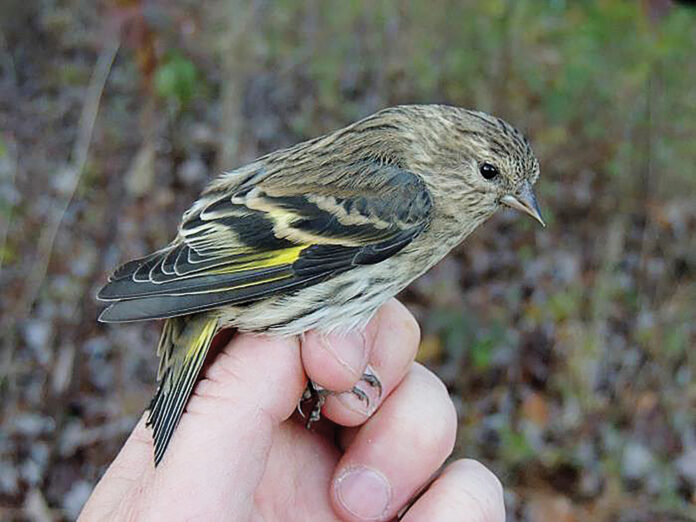
If you enjoy feeding the birds throughout the winter months, you may be in for a special treat this year. According to the annual Winter Finch Forecast, two species of northern finches have already begun irrupting southward and invading our feeders.
This official report, issued in mid-September, is one I await each autumn with great anticipation. Started in the 1970’s it offers predictions of which northern finch species will be forced to migrate south into the United States from Canada for the winter months in search of food.
Winter Finch Forecast

Birders everywhere lost a well-known icon in 2023, Canadian ornithologist, Ron Pittaway, who was the founder of this much anticipated, yearly forecast. In the northernmost reaches of Algonquin Provincial Park in Ontario, Pittaway would spend late summer traipsing through the boreal forests, evaluating the seed and berry crops. By studying alder, birch and other coniferous trees as well as berry-producing species such as mountain ash, he was able to make predictions as to which finches would have sufficient food to remain in Canada and which species would be forced to wing their way south into the United States to locate life-saving food sources. Such movements as this are referred to as “irruptions”. In all, his predictions focused on eight finch species including purple finches, white-winged crossbills, red crossbills, pine grosbeaks, pine siskins, common redpolls, hoary redpolls and evening grosbeaks. He also made predictions for three other species whose food preferences are similar to the finches — blue jays, red-breasted nuthatches and Bohemian waxwings.
Pittaway was not alone in his work. He had a network of around 45 volunteer citizen scientists to assist him with his surveys. In late summer he would have them rate the local seed crops in their area, giving them a grade of poor, fair, good, excellent or bumper. Trees surveyed included hemlocks, spruces, pines and mountain ashes. All the data collected would be compiled and a map of the seed crops would be generated. This in turn would be intensely scrutinized before the final forecast was issued in late September.
Pittaway’s work was as much an art as it was a science, and, being a perfectionist, his results were almost always spot-on. Pittaway announced his retirement in 2020, but that was not the end of the Winter Finch Forecast. Tyler Hoar, his close friend and collaborator was quick to step in as his successor. Having been under Pittaway’s tutelage for many years, Tyler vowed to work with the same formula, while expanding his network of contacts. So far, his forecasts have remained extremely accurate.
2023 irruptions

The most noticeable irruption this winter will be from a species of small finch known as a pine siskin.
This streaked bird, marked somewhat like a sparrow, sports a sharp, pointed beak, notched tail and long wings. Yellow coloration in the wings and tail are evident in most birds. If you were to see the silhouette of the pine siskin you have to liken it to that of a goldfinch. In fact, pine siskins often feed in the company of goldfinches. These mixed flocks can be found frequenting feeding stations and are often heard before they are seen. With vocalizations resembling the goldfinch, the siskin’s telltale calling card is an ascending buzz that starts low and rises up, much like a zipper being zipped.
This year’s Winter Finch Forecast states, “Significant numbers of siskins have started to leave the boreal forest in mid-September, with thousands reported daily at migration monitoring stations from Duluth, Minnesota eastward to Tadoussac Quebec. With the poor White Spruce crop in much of the boreal forest, there should be a moderate to possibly strong flight of siskins southward this fall. This entertaining species prefers nyjer seeds in silo or sock feeders.”
Another winter finch that we might catch sight of this winter is the common redpoll. This is a delightful little finch with a black face and throat, red cap and rosy breast. It is commonly discovered mixed in with goldfinches and siskins and its chattering call can be heard ringing throughout the landscape. The Winter Finch Forecast states, “Across the whole boreal forest, a good alder crop has been reported. However, in the same areas, the spruce and birch crops are poor to below average. Expect a moderate flight south out of the boreal forest. Watch for redpolls on birches in weedy fields and at bird feeders offering nyjer and black oil sunflower seeds.”
Banding

As a licensed bird bander of 30+ years, I maintain a banding station at my feeders every winter. While permanent residents such as chickadees, titmice, cardinals, woodpeckers and nuthatches make up the majority of the species that I band, I relish the irruption years when I can get my hands on some of these rarer species for an up-close view. By putting a band on these individuals, scientists hope that someday they will be recovered, perhaps by another bander, and their migratory patterns, longevity and other important information can be assessed. In fact, one of the common redpolls that I banded during the 2013 irruption was recovered the following spring by a bander in Ontario. The photos included in this article are of finches from the most recent irruption in 2020.
As I sit here typing this, my feeders, stocked full of black-oil sunflower and nyjer (thistle) seed are being visited by a variety of winter residents. Yet, I can’t help but find myself fantasizing about a hearty irruption of winter finches stopping by for a visit. My camera sits at the ready and my nets are set to be opened to capture and band these beauties should they swing by. And I can thank Ron Pittaway for the development of his Winter Finch Forecast in helping me to do so.
To read the 2023-2024 Winter Finch Forecast in its entirety, please visit finchnetwork.org/winter-finch-forecast-2023-2024.











